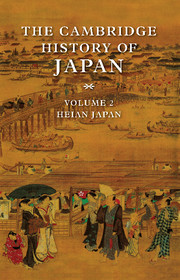Book contents
- Frontmatter
- Introduction
- 1 The Heian court, 794–1070
- 2 The capital and its society
- 3 Land and society
- 4 Provincial administration and land tenure in early Heian
- 5 Chinese learning and intellectual life
- 6 Aristocratic culture
- 7 Aristocratic Buddhism
- 8 Religious practices
- 9 Insei
- 10 The rise of the warriors
- Works cited
- Glossary-index
- Japan in the Heian period"
- References
9 - Insei
Published online by Cambridge University Press: 28 March 2008
- Frontmatter
- Introduction
- 1 The Heian court, 794–1070
- 2 The capital and its society
- 3 Land and society
- 4 Provincial administration and land tenure in early Heian
- 5 Chinese learning and intellectual life
- 6 Aristocratic culture
- 7 Aristocratic Buddhism
- 8 Religious practices
- 9 Insei
- 10 The rise of the warriors
- Works cited
- Glossary-index
- Japan in the Heian period"
- References
Summary
In late Heian times, the retired sovereigns Shirakawa, Toba, and Go-Shirakawa dominated the court as few former sovereigns, reigning or retired, had done. Later historians referred to this form of political domination as insei or “cloister government,” a term derived from the fact that abdicated emperors resided in well-appointed villas or religious cloisters (in) from which they conducted politics (sei). The ex-sovereign's office had numerous subordinate bureaus staffed by courtiers who supported his interests at court and supervised extensive provincial estates. Retired emperors so dominated the Heian court that historians call the period 1086–1185, stretching from late Heian to the beginning of Kamakura times, the Insei period.
Once a person has attained the highest office in the land, it is difficult to revert to the status of a common citizen; the aura of authority remains. In modern times, this is true of former kings, presidents, and prime ministers; however, the more hierarchic the society, the more we should expect the residual authority to remain viable. In Heian Japan, substantial authority remained with a former sovereign. Although rulers everywhere abdicate, nowhere has the practice been as common as it was in Japan. And nowhere else did former sovereigns regularly influence national affairs so significantly. A brief recapitulation of some features of the Japanese dynasty is necessary background for an understanding of this phenomenon.
- Type
- Chapter
- Information
- The Cambridge History of Japan , pp. 576 - 643Publisher: Cambridge University PressPrint publication year: 1999
References
- 1
- Cited by



